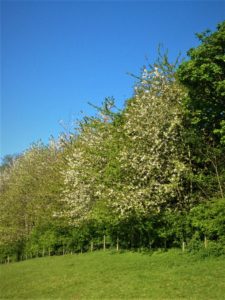
Wild cherry blooming
Our media has taken to demonising cold winter blasts, with headlines alerting us to forecasts of the ‘Beast-from-the-East’. But how lovely it has been to have a winter with some real winter weather! At Bron Haul, we had snow twice in January 2021, which stayed on the ground for a total of 13 days and we logged a minimum temperature of -4oC. In 2019 we had a winter of record-breaking high temperatures, with February 2019 being the second warmest on record and the first to log over 20oC2. But what does it matter if we experience warmer winters, and if frosty winter weather becomes less predictable?
Plants and animals time events such as bud burst, flowering, migration and breeding with the climate. This is called phenology. Citizen science data recording the arrival of UK summer-visiting birds shows that many are arriving significantly earlier in the year. Blackcaps, chiffchaffs, redstarts and swallows are amongst those that are arriving over 10 days earlier than in the 1960s1. However, their food sources, be they plants or insects, need to emerge from winter earlier too, if our visitors are to recover from their long journeys and go on to breed successfully.
Leaf bud burst in trees comes earlier in warmer springs. In North Wales last year oak and birch came into leaf nearly 10 days earlier than usual (compared to the average 1999-2018). This may give our trees a longer growing season and an early food source for their resident herbivours.

Oak and larch spring into life
However, many of our tree species require a cold spell to reproduce. Trees shed seed in the late summer and autumn, but how do they know when to germinate? Seed dormancy prevents germination in early winter. This dormancy is switched off when seeds experience a cold snap later in winter and the seeds are then primed ready to germinate when warm weather arrives in spring. Warm winters may fail to switch off seed dormancy and make it harder for our woodlands to regenerate.
Similarly, the tips of branches stop growing towards the end of the year in response to short day length. The bud that forms on the end of these branches is dormant. A period of cold weather brings the bud out of dormancy, making it ready to respond to warmer weather to break out into leaf.
So, let’s enjoy our blasts of cold winter weather. They give our native trees the reset they need to burst into a glorious spring of green canopy with armies of seedling in our woodland understorey. We are looking forward to it!
1 Newson, S.E. et al (2016) Long‐term changes in the migration phenology of UK breeding birds detected by large‐scale citizen science recording schemes. Ibis 158 (3): 481-495.
2Kendon, M. et al (2019) State of the UK Climate 2019. International Journal of Climatology 40(S1): 1-69.
